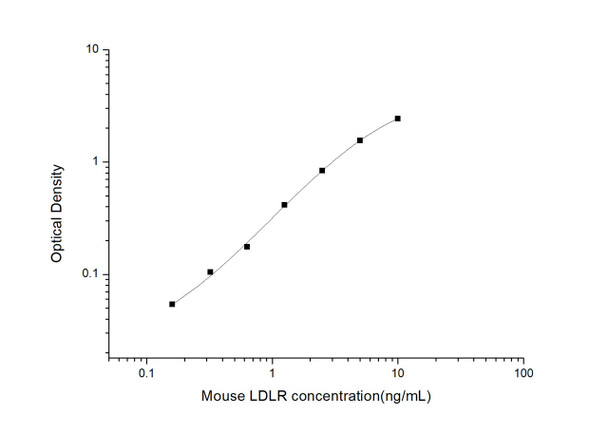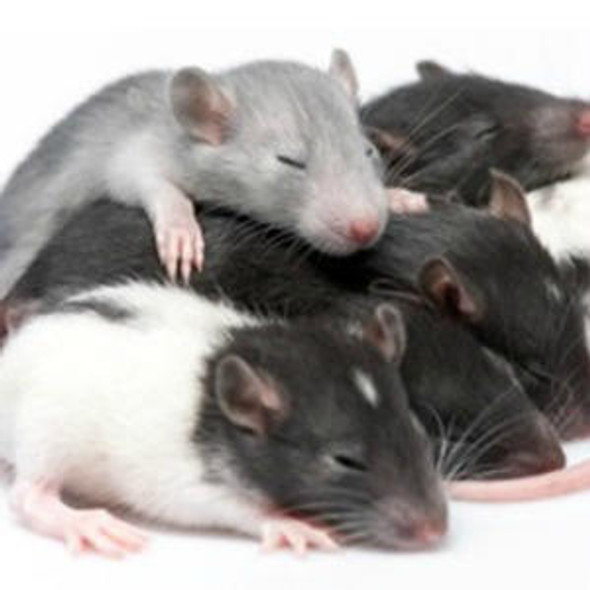Mouse Metabolism ELISA Kits
Mouse LDLR (Low Density Lipoprotein Receptor) ELISA Kit (MOES01357)
- SKU:
- MOES01357
- Product Type:
- ELISA Kit
- Size:
- 96 Assays
- Uniprot:
- P35951
- Sensitivity:
- 0.09ng/mL
- Range:
- 0.16-10ng/mL
- ELISA Type:
- Sandwich
- Synonyms:
- FH, FHC, LDLCQ2, Familial Hypercholesterolemia
- Reactivity:
- Mouse
- Sample Type:
- Serum, plasma and other biological fluids
- Research Area:
- Metabolism
Description
| Assay type: | Sandwich |
| Format: | 96T |
| Assay time: | 4.5h |
| Reactivity: | Mouse |
| Detection Method: | Colormetric |
| Detection Range: | 0.16-10 ng/mL |
| Sensitivity: | 0.10 ng/mL |
| Sample Volume Required Per Well: | 100µL |
| Sample Type: | Serum, plasma and other biological fluids |
| Specificity: | This kit recognizes Mouse LDLR in samples. No significant cross-reactivity or interference between Mouse LDLR and analogues was observed. |
This ELISA kit uses Sandwich-ELISA as the method. The micro ELISA plate provided in this kit has been pre-coated with an antibody specific to Mouse LDLR. Standards or samples are added to the appropriate micro ELISA plate wells and combined with the specific antibody. Then a biotinylated detection antibody specific for Mouse LDLR and Avidin-Horseradish Peroxidase (HRP) conjugate are added to each micro plate well successively and incubated. Free components are washed away. The substrate solution is added to each well. Only those wells that contain Mouse LDLR, biotinylated detection antibody and Avidin-HRP conjugate will appear blue in color. The enzyme-substrate reaction is terminated by adding Stop Solution and the color turns yellow. The optical density (OD) is measured spectrophotometrically at a wavelength of 450 nm ± 2 nm. The OD value is proportional to the concentration of Mouse LDLR. The concentration of Mouse LDLR in samples can be calculated by comparing the OD of the samples to the standard curve.
| UniProt Protein Function: | LDLR: Binds LDL, the major cholesterol-carrying lipoprotein of plasma, and transports it into cells by endocytosis. In order to be internalized, the receptor-ligand complexes must first cluster into clathrin-coated pits. In case of HIV-1 infection, functions as a receptor for extracellular Tat in neurons, mediating its internalization in uninfected cells. Defects in LDLR are the cause of familial hypercholesterolemia (FH); a common autosomal semi- dominant disease that affects about 1 in 500 individuals. The receptor defect impairs the catabolism of LDL, and the resultant elevation in plasma LDL-cholesterol promotes deposition of cholesterol in the skin (xanthelasma), tendons (xanthomas), and coronary arteries (atherosclerosis). Belongs to the LDLR family. 4 isoforms of the human protein are produced by alternative splicing. |
| UniProt Protein Details: | Protein type:Cell surface; Membrane protein, integral; Receptor, misc. Chromosomal Location of Human Ortholog: 19p13. 2 Cellular Component: Golgi apparatus; cell surface; membrane; integral to plasma membrane; lysosome; late endosome; early endosome; plasma membrane; endosome membrane; coated pit; receptor complex; external side of plasma membrane Molecular Function:low-density lipoprotein receptor activity; very-low-density lipoprotein receptor activity; protein binding; low-density lipoprotein binding; clathrin heavy chain binding; calcium ion binding; glycoprotein binding Biological Process: lipoprotein catabolic process; cholesterol metabolic process; phototransduction, visible light; receptor-mediated endocytosis; cholesterol transport; viral reproduction; cholesterol absorption; endocytosis; lipoprotein metabolic process; cholesterol homeostasis; phospholipid transport; lipid metabolic process; retinoid metabolic process Disease: Hypercholesterolemia, Familial |
| NCBI Summary: | The low density lipoprotein receptor (LDLR) gene family consists of cell surface proteins involved in receptor-mediated endocytosis of specific ligands. Low density lipoprotein (LDL) is normally bound at the cell membrane and taken into the cell ending up in lysosomes where the protein is degraded and the cholesterol is made available for repression of microsomal enzyme 3-hydroxy-3-methylglutaryl coenzyme A (HMG CoA) reductase, the rate-limiting step in cholesterol synthesis. At the same time, a reciprocal stimulation of cholesterol ester synthesis takes place. Mutations in this gene cause the autosomal dominant disorder, familial hypercholesterolemia. Alternate splicing results in multiple transcript variants. [provided by RefSeq, Sep 2010] |
| UniProt Code: | P35951 |
| NCBI GenInfo Identifier: | 4504975 |
| NCBI Gene ID: | 3949 |
| NCBI Accession: | NP_000518. 1 |
| UniProt Secondary Accession: | P35951,P35951, |
| UniProt Related Accession: | P01130 |
| Molecular Weight: | 140kDa |
| NCBI Full Name: | low-density lipoprotein receptor isoform 1 |
| NCBI Synonym Full Names: | low density lipoprotein receptor |
| NCBI Official Symbol: | LDLR |
| NCBI Official Synonym Symbols: | FH; FHC; FHCL1; LDLCQ2 |
| NCBI Protein Information: | low-density lipoprotein receptor |
| UniProt Protein Name: | Low-density lipoprotein receptor |
| Protein Family: | LDLR chaperone |
| UniProt Gene Name: | LDLR |
| UniProt Entry Name: | LDLR_HUMAN |
As the OD values of the standard curve may vary according to the conditions of the actual assay performance (e. g. operator, pipetting technique, washing technique or temperature effects), the operator should establish a standard curve for each test. Typical standard curve and data is provided below for reference only.
| Concentration (ng/mL) | O.D | Average | Corrected |
| 10 | 2.485 2.493 | 2.489 | 2.432 |
| 5 | 1.601 1.623 | 1.612 | 1.555 |
| 2.5 | 0.909 0.883 | 0.896 | 0.839 |
| 1.25 | 0.456 0.486 | 0.471 | 0.414 |
| 0.63 | 0.246 0.22 | 0.233 | 0.176 |
| 0.32 | 0.175 0.149 | 0.162 | 0.105 |
| 0.16 | 0.106 0.116 | 0.111 | 0.054 |
| 0 | 0.056 0.058 | 0.057 | -- |
Precision
Intra-assay Precision (Precision within an assay): 3 samples with low, mid range and high level Mouse LDLR were tested 20 times on one plate, respectively.
Inter-assay Precision (Precision between assays): 3 samples with low, mid range and high level Mouse LDLR were tested on 3 different plates, 20 replicates in each plate.
| Intra-assay Precision | Inter-assay Precision | |||||
| Sample | 1 | 2 | 3 | 1 | 2 | 3 |
| n | 20 | 20 | 20 | 20 | 20 | 20 |
| Mean (ng/mL) | 0.50 | 0.88 | 4.90 | 0.54 | 0.87 | 4.89 |
| Standard deviation | 0.03 | 0.04 | 0.27 | 0.03 | 0.04 | 0.16 |
| C V (%) | 6.00 | 4.55 | 5.51 | 5.56 | 4.60 | 3.27 |
Recovery
The recovery of Mouse LDLR spiked at three different levels in samples throughout the range of the assay was evaluated in various matrices.
| Sample Type | Range (%) | Average Recovery (%) |
| Serum (n=5) | 86-100 | 91 |
| EDTA plasma (n=5) | 92-104 | 99 |
| Cell culture media (n=5) | 90-102 | 97 |
Linearity
Samples were spiked with high concentrations of Mouse LDLR and diluted with Reference Standard & Sample Diluent to produce samples with values within the range of the assay.
| Serum (n=5) | EDTA plasma (n=5) | Cell culture media (n=5) | ||
| 1:2 | Range (%) | 89-101 | 88-102 | 89-102 |
| Average (%) | 95 | 94 | 95 | |
| 1:4 | Range (%) | 91-107 | 82-94 | 86-99 |
| Average (%) | 99 | 86 | 92 | |
| 1:8 | Range (%) | 91-109 | 80-95 | 86-97 |
| Average (%) | 99 | 87 | 92 | |
| 1:16 | Range (%) | 87-98 | 85-98 | 87-99 |
| Average (%) | 92 | 90 | 93 |
An unopened kit can be stored at 4°C for 1 month. If the kit is not used within 1 month, store the items separately according to the following conditions once the kit is received.
| Item | Specifications | Storage |
| Micro ELISA Plate(Dismountable) | 8 wells ×12 strips | -20°C, 6 months |
| Reference Standard | 2 vials | |
| Concentrated Biotinylated Detection Ab (100×) | 1 vial, 120 µL | |
| Concentrated HRP Conjugate (100×) | 1 vial, 120 µL | -20°C(shading light), 6 months |
| Reference Standard & Sample Diluent | 1 vial, 20 mL | 4°C, 6 months |
| Biotinylated Detection Ab Diluent | 1 vial, 14 mL | |
| HRP Conjugate Diluent | 1 vial, 14 mL | |
| Concentrated Wash Buffer (25×) | 1 vial, 30 mL | |
| Substrate Reagent | 1 vial, 10 mL | 4°C(shading light) |
| Stop Solution | 1 vial, 10 mL | 4°C |
| Plate Sealer | 5 pieces | |
| Product Description | 1 copy | |
| Certificate of Analysis | 1 copy |
- Set standard, test sample and control (zero) wells on the pre-coated plate and record theirpositions. It is recommended to measure each standard and sample in duplicate. Note: addall solutions to the bottom of the plate wells while avoiding contact with the well walls. Ensuresolutions do not foam when adding to the wells.
- Aliquot 100µl of standard solutions into the standard wells.
- Add 100µl of Sample / Standard dilution buffer into the control (zero) well.
- Add 100µl of properly diluted sample (serum, plasma, tissue homogenates and otherbiological fluids) into test sample wells.
- Cover the plate with the sealer provided in the kit and incubate for 90 min at 37°C.
- Aspirate the liquid from each well, do not wash. Immediately add 100µL of BiotinylatedDetection Ab working solution to each well. Cover the plate with a plate seal and gently mix. Incubate for 1 hour at 37°C.
- Aspirate or decant the solution from the plate and add 350µL of wash buffer to each welland incubate for 1-2 minutes at room temperature. Aspirate the solution from each well andclap the plate on absorbent filter paper to dry. Repeat this process 3 times. Note: a microplatewasher can be used in this step and other wash steps.
- Add 100µL of HRP Conjugate working solution to each well. Cover with a plate seal andincubate for 30 min at 37°C.
- Aspirate or decant the solution from each well. Repeat the wash process for five times asconducted in step 7.
- Add 90µL of Substrate Reagent to each well. Cover with a new plate seal and incubate forapproximately 15 min at 37°C. Protect the plate from light. Note: the reaction time can beshortened or extended according to the actual color change, but not by more than 30min.
- Add 50 µL of Stop Solution to each well. Note: Adding the stop solution should be done inthe same order as the substrate solution.
- Determine the optical density (OD value) of each well immediately with a microplate readerset at 450 nm.






